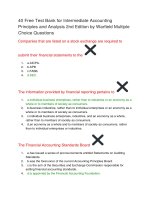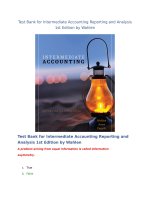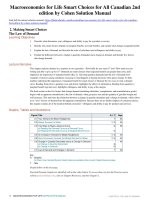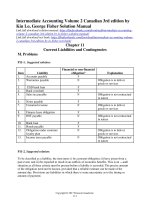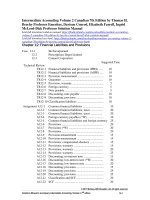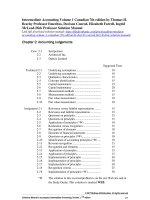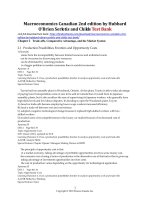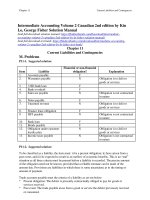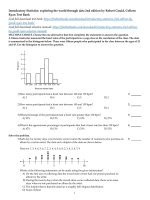Intermediate accounting volume 1 canadian 2nd edition by lo fisher test bank
Bạn đang xem bản rút gọn của tài liệu. Xem và tải ngay bản đầy đủ của tài liệu tại đây (560.32 KB, 22 trang )
Intermediate Accounting Volume 1 Canadian 2nd edition by Kin
Lo, George Fisher Test Bank
Link full download test bank: />Link full download solution manual: />Chapter 2 Conceptual Frameworks for Financial Reporting
Learning Objective 1
1) Which of the following is NOT a purpose of a conceptual framework of accounting concepts
and financial reporting objectives?
A) To increase the user's ability to understand financial statements.
B) To increase financial statement users' confidence in financial
reporting.
C) To provide a foundation for detailed accounting and reporting rules.
D) To enhance comparability among companies' financial statements.
Answer: C
Diff: 1
Skill: Conceptual
Objective: 2.1 Explain the role of a conceptual framework for financial reporting and the reasons for having
conceptual frameworks.
2) Which of the following is NOT correct about the conceptual framework in accounting?
A) It is the basis for standard-setting for accounting standard setting bodies.
B) It is based on fundamental accounting truths derived from the laws of nature.
C) It can be used to solve emerging or complex accounting problems.
D) It can be used to develop consistent and comparable accounting principles.
Answer: B
Diff: 1
Skill: Conceptual
Objective: 2.1 Explain the role of a conceptual framework for financial reporting and the reasons for having
conceptual frameworks.
3) Which is a purpose of the conceptual framework in accounting?
A) To support principles-based accounting standards, principles and practices.
B) To provide rules from which decision-useful financial information can be developed.
C) To promote global consistency, acceptance and adoption of IFRS around the globe.
D) To develop different accounting practices between countries around the globe.
Answer: A
Diff: 1
Skill: Conceptual
Objective: 2.1 Explain the role of a conceptual framework for financial reporting and the reasons for having
conceptual frameworks.
4) The underlying or fundamental objective of the accounting conceptual framework is
A) decision usefulness.
B) comparability.
C) representational faithfulness.
D) understandability.
Answer: A
Diff: 1
Skill: Conceptual
Objective: 2.1 Explain the role of a conceptual framework for financial reporting and the reasons for having
conceptual frameworks.
2-1
Intermediate Accounting, Volume 1, 2e
Chapter 2 – Conceptual Frameworks for Financial Reporting
5) Provide three reasons for the importance of the conceptual framework for financial reporting.
Answer: A conceptual framework is like a strategic business plan that identifies demands of users and
how to supply a product that meets those demands.
The framework provides overall plans to guide implementation: the evaluation of more specific
accounting standards and the application of accounting standards to specific circumstances.
As business plans, they differ in response to variations in the environments for which they are
developed, and they change from time to time to respond to changes in market conditions.
It provides the foundational principles, assumptions and principles upon which accounting standards
are built.
This foundation ensures accounting standards are consistent with each other (e.g. the definition of an
"asset" ensures that the accounting for fixed assets and intangible assets are based on consistent
recognition criteria).
The foundational concepts help accountants determine the appropriate accounting in circumstances
for which specific standards may not exist.
Diff: 2
Skill: Conceptual
Objective: 2.1 Explain the role of a conceptual framework for financial reporting and the reasons for having
conceptual frameworks.
6) Which of the following is part of the IFRS Framework?
A) Statement of financial position.
B) Elements of financial statements.
C) Information Asymmetry.
D) Financial statement
notes.
Answer: B
Explanation: B) These are the basic items/categories of items that appear in the financial statements
Diff: 2
Skill: Conceptual
Objective: 2.1 Explain the role of a conceptual framework for financial reporting and the reasons for having
conceptual frameworks.
2-2
Copyright © 2014 Pearson Canada Inc.
Intermediate Accounting, Volume 1, 2e
Chapter 2 – Conceptual Frameworks for Financial Reporting
Learning Objective 2
1) Which is NOT a qualitative characteristic of financial information in the IFRS
Framework?
A) Understandability.
B) Historical cost.
C) Representational
faithfulness.
D) Comparability.
Answer: B
Diff: 1
Skill: Conceptual
Objective: 2.2 Explain the rationale for each of the eight major components of these frameworks and synthesize these
components into an integrated whole.
2) Which is an assumption of financial information in the IFRS Framework?
A) Accrual basis of accounting.
B) Historical cost.
C) Timeliness.
D) Financial capital
maintenance.
Answer: D
Diff: 1
Skill: Conceptual
Objective: 2.2 Explain the rationale for each of the eight major components of these frameworks and synthesize these
components into an integrated whole.
3) Which is NOT an element of financial information in the IFRS Framework?
A) Other comprehensive income.
B) Assets.
C) Income.
D) Liabilities.
Answer: A
Diff: 1
Skill: Conceptual
Objective: 2.2 Explain the rationale for each of the eight major components of these frameworks and synthesize these
components into an integrated whole.
4) Which is NOT a criteria for recognition of financial information in the IFRS Framework?
A) The amount is reasonably measurable.
B) The expenses should be matched with revenues.
C) The amount must be measured at historical cost.
D) Inflow of outflow of cash flows are probable.
Answer: C
Diff: 1
Skill: Conceptual
Objective: 2.2 Explain the rationale for each of the eight major components of these frameworks and synthesize these
components into an integrated whole.
2-3
Intermediate Accounting, Volume 1, 2e
Chapter 2 – Conceptual Frameworks for Financial Reporting
5) Who are NOT users of financial information under the IFRS
Framework?
A) Present investors.
B) Potential investors.
C) Creditors.
D) Management.
Answer: D
Diff: 1
Skill: Conceptual
Objective: 2.2 Explain the rationale for each of the eight major components of these frameworks and synthesize these
components into an integrated whole.
6) What is NOT an information need of users of financial information under the IFRS Framework?
A) Information on the amount of cash flows.
B) Information about the timing of future cash flows.
C) Information on the uncertainty of cash flows.
D) Information about the amount of past cash
flows. Answer: D
Diff: 2
Skill: Conceptual
Objective: 2.2 Explain the rationale for each of the eight major components of these frameworks and synthesize these
components into an integrated whole.
7) Which financial statement is NOT needed under the IFRS Framework?
A) Balance sheet.
B) Statement of retained earnings.
C) Income statement.
D) Statement of cash
flows. Answer: B
Diff: 2
Skill: Conceptual
Objective: 2.2 Explain the rationale for each of the eight major components of these frameworks and synthesize these
components into an integrated whole.
8) What information does the balance sheet provide to users of financial information under the
IFRS Framework?
A) Information about changes in liabilities over a period of time.
B) Information about changes in resources over a period of time.
C) Information about the performance of a company over a period of
time.
D) Information about the state of a company at a point in time.
Answer: D
Diff: 2
Skill: Conceptual
Objective: 2.2 Explain the rationale for each of the eight major components of these frameworks and synthesize these
components into an integrated whole.
2-4
Copyright © 2014 Pearson Canada Inc.
Intermediate Accounting, Volume 1, 2e
Chapter 2 – Conceptual Frameworks for Financial Reporting
9) What decision would users of financial information NOT need to make under the IFRS
Framework?
A) Decide whether to invest in an entity.
B) Information on an entity's economic performance.
C) Amount of money to borrow from an entity.
D) Assessment of the riskiness of cash
flows.
Answer: C
Diff: 3
Skill: Conceptual
Objective: 2.2 Explain the rationale for each of the eight major components of these frameworks and synthesize these
components into an integrated whole.
10) What decision would users of financial information need to make under the IFRS Framework?
A) Determining whether to lend to the company.
B) Determining if a company is an ethical company.
C) Determining if the liquidation values are accurate.
D) Determine if the company is socially
responsible.
E) Answer: A
Diff: 3
Skill: Conceptual
Objective: 2.2 Explain the rationale for each of the eight major components of these frameworks and synthesize these
components into an integrated whole.
11) Financial statements under the IFRS Framework do NOT help users with what kind of objective(s)?
A) Alleviating moral hazard.
B) Forecasting future product growth.
C) Prediction of future earnings.
D) Evaluating the riskiness of an
investment.
Answer: B
Diff: 3
Skill: Conceptual
Objective: 2.2 Explain the rationale for each of the eight major components of these frameworks and synthesize these
components into an integrated whole.
12) Which statement best explains the qualitative characteristic of "relevance"?
A) Financial reports should be understandable to the users of the information.
B) Omitting information would influence a user's economic decision.
C) Information should influence a user's economic decisions.
D) Financial reports should be accurate and complete.
Answer: C
Diff: 2
Skill: Conceptual
Objective: 2.2 Explain the rationale for each of the eight major components of these frameworks and synthesize these
components into an integrated whole.
Intermediate Accounting, Volume 1, 2e
Chapter 2 – Conceptual Frameworks for Financial Reporting
13) Which statement best explains the concept of "representational faithfulness"?
A) Transactions should be recorded in accordance with their substance rather than their legal form.
B) Transactions should be recorded in accordance with their legal form rather than their substance.
C) Transactions should be recorded accurately and completely to be useful to financial statement users.
D) Transactions should be recorded using the rules and guidelines provided in the accounting standards.
Answer: A
Diff: 3
Skill: Conceptual
Objective: 2.2 Explain the rationale for each of the eight major components of these frameworks and synthesize these
components into an integrated whole.
14) When actual financial statements routinely report results that overstate or understate a
company's financial position, which qualitative characteristic is violated?
A) Relevance.
B) Neutrality.
C) Conservatism.
D) Reliability.
Answer: B
Diff: 2
Skill: Conceptual
Objective: 2.2 Explain the rationale for each of the eight major components of these frameworks and synthesize these
components into an integrated whole.
15) What information does the income statement provide to users of financial information under the
IFRS Framework?
A) Information about changes in liabilities over a period of time.
B) Information about changes in resources over a period of time.
C) Information about the performance over a period of time.
D) Information about the state of a company at a point in time.
Answer: C
Diff: 2
Skill: Conceptual
Objective: 2.2 Explain the rationale for each of the eight major components of these frameworks and synthesize these
components into an integrated whole.
16) Which of the following is an attribute of "relevance"?
A) Verifiability.
B) Predictive value.
C) Free from error.
D) Comparability.
Answer: B
Diff: 1
Skill: Conceptual
Objective: 2.2 Explain the rationale for each of the eight major components of these frameworks and synthesize these
components into an integrated whole.
2-6
Copyright © 2014 Pearson Canada Inc.
Intermediate Accounting, Volume 1, 2e
Chapter 2 – Conceptual Frameworks for Financial Reporting
17) Which of the following is an attribute of "representational
faithfulness"? A) Historical cost.
B) Confirmatory value.
C) Neutrality.
D) Understandability.
Answer: C
Diff: 1
Skill: Conceptual
Objective: 2.2 Explain the rationale for each of the eight major components of these frameworks and synthesize these
components into an integrated whole.
18) Which statement best explains the qualitative characteristic of "completeness"?
A) Financial statements should represent the underlying transactions, assets and liabilities.
B) Omission of financial information that would influence a user's economic decision.
C) Financial information should not contain errors or bias.
D) Financial statements should not omit material items or transactions.
Answer: D
Diff: 2
Skill: Conceptual
Objective: 2.2 Explain the rationale for each of the eight major components of these frameworks and synthesize these
components into an integrated whole.
19) Which qualitative characteristic of financial information alleviates "moral
hazard"?
A) Neutrality.
B) Predictive value.
C) Timeliness.
D) Comparability.
Answer: A
Explanation: A) Representationally faithful information alleviates moral hazard; neutrality is an attribute
of representational faithfulness.
Diff: 3
Skill: Conceptual
Objective: 2.2 Explain the rationale for each of the eight major components of these frameworks and synthesize these
components into an integrated whole.
20) Which of the following characteristic of financial information alleviates "information asymmetry"?
A) Completeness.
B) Verifiability.
C) Confirmatory value.
D) Materiality.
Answer: C
Explanation: C) Relevant information alleviates information asymmetry; confirmatory value is an
attribute of relevance.
Diff: 3
Skill: Conceptual
Objective: 2.2 Explain the rationale for each of the eight major components of these frameworks and synthesize these
components into an integrated whole.
2-7
Copyright © 2014 Pearson Canada Inc.
Intermediate Accounting, Volume 1, 2e
Chapter 2 – Conceptual Frameworks for Financial Reporting
21) Which statement best explains the meaning of "recognition" in financial reporting?
A) Determining where items should be presented in the body of the financial statements.
B) Presenting an item in the financial statements, rather than simply disclosing in the
notes.
C) Quantifying items so that they can be presented in the body of the financial statements.
D) Presenting expenses in the same accounting period as the related revenues.
Answer: B
Diff: 2
Skill: Conceptual
Objective: 2.2 Explain the rationale for each of the eight major components of these frameworks and synthesize these
components into an integrated whole.
22) Which statement best explains the meaning of "measurement" in financial reporting?
A) Determining where items should be presented in the body of the financial statements.
B) Presenting an item in the financial statements but not in the notes.
C) Quantifying items so that they can be presented in the body of the financial statements.
D) Presenting expenses in the same accounting period as the related revenues.
Answer: C
Diff: 2
Skill: Conceptual
Objective: 2.2 Explain the rationale for each of the eight major components of these frameworks and synthesize these
components into an integrated whole.
23) Which statement best explains the meaning of "comparability" in financial
reporting?
A) Financial information that is available quickly to financial statement users.
B) Financial information that can be objectively confirmed by another person.
C) Financial reports that are comprehendible to the users of such reports.
D) Financial statement preparers using consistent accounting policies year over year.
Answer: D
Diff: 2
Skill: Conceptual
Objective: 2.2 Explain the rationale for each of the eight major components of these frameworks and synthesize these
components into an integrated whole.
24) Which statement best explains the meaning of "presentation" in financial reporting?
A) Determining where items should be presented in the body of the financial statements.
B) Presenting an item in the body of the financial statements and in the notes.
C) Quantifying items so that they can be presented in the body of the financial statements.
D) Presenting expenses in the same accounting period as the related revenues.
Answer: A
Diff: 3
Skill: Conceptual
Objective: 2.2 Explain the rationale for each of the eight major components of these frameworks and synthesize these
components into an integrated whole.
2-8
Copyright © 2014 Pearson Canada Inc.
Intermediate Accounting, Volume 1, 2e
Chapter 2 – Conceptual Frameworks for Financial Reporting
25) When are financial items recognized in the financial statements?
A) Items are recognized if the fair value amounts can be determined.
B) Items are recognized if the inflows or outflows of resources are probable.
C) Items are recognized if the future gains will result from disposal of the
item.
D) Items are recognized if there are no measurement uncertainties.
Answer: B
Diff: 2
Skill: Conceptual
Objective: 2.2 Explain the rationale for each of the eight major components of these frameworks and synthesize these
components into an integrated whole.
26) What is the most commonly used measurement basis?
A) Current cost.
B) Realizable value.
C) Historical cost.
D) Present value.
Answer: C
Diff: 2
Skill: Conceptual
Objective: 2.2 Explain the rationale for each of the eight major components of these frameworks and synthesize these
components into an integrated whole.
27) Which of the following is/are constraints in the financial reporting process?
A) Classifying a revenue versus an expense in the income statement.
B) Using the historical cost versus the fair value method to measure transactions.
C) Recognizing an asset versus a liability in the balance sheet.
D) Benefits of information versus the costs of producing that information.
Answer: D
Diff: 2
Skill: Conceptual
Objective: 2.2 Explain the rationale for each of the eight major components of these frameworks and synthesize these
components into an integrated whole.
28) Which of the following accurately describes the objective of financial reporting under the
IFRS Conceptual Framework?
A) The Framework focuses on a narrow set of users such as investors and lenders. B)
Special purpose financial statements are required under the Framework.
C) In the Framework, users include a broad range such as employees and customers.
D) Under the Framework, general purpose financial statements increase moral hazard.
Answer: A
Diff: 2
Skill: Conceptual
Objective: 2.2 Explain the rationale for each of the eight major components of these frameworks and synthesize these
components into an integrated whole.
2-9
Copyright © 2014 Pearson Canada Inc.
Intermediate Accounting, Volume 1, 2e
Chapter 2 – Conceptual Frameworks for Financial Reporting
29) Identify the eight major components of the conceptual framework for accounting. Explain how these
components interact with the demand for and supply of financial information.
Answer:
• The eight components are: users of financial statements, needs/objectives of users, qualitative
characteristics, elements, recognition criteria, measurement considerations, constraints and assumptions.
• The framework can be viewed and better understood as a plan for the supply of accounting
information to meet the demands of potential users.
• Analysis of the demand for accounting information requires specifying the users (target market), their
information needs (customer needs), and the desirable characteristics of information (desirable product
characteristics).
• The supply side of a conceptual framework involves identifying the elements of financial statements
(potential components), followed by criteria for recognition in the financial statements (product
design), and measurement (customization to specific needs).
• Whether the supply of information is able to meet the users' demands also depends on constraints on
financial reporting and the suitability of assumptions made in the planning process.
Diff: 2
Skill: Conceptual
Objective: 2.2 Explain the rationale for each of the eight major components of these frameworks and synthesize these
components into an integrated whole.
2-10
Copyright © 2014 Pearson Canada Inc.
Intermediate Accounting, Volume 1, 2e
Chapter 2 – Conceptual Frameworks for Financial Reporting
30) Indicate the qualitative characteristic being described in each situation below:
Qualitative characteristic
Answer:
Qualitative characteristic
Verifiability
Relevance
Representational faithfulness
Neutrality
Understandability
Situation
The degree to which different people would
agree with the chosen representation in the
financial reports.
Information that is able to provide feedback
about past performance or helps make future
predictions of performance.
Information that lacks errors and bias, and users
can depend on the information to be a faithful
representation of what it is purported to
represent.
Information that is free from bias.
The ease with which users are able to
comprehend financial reports.
Situation
The degree to which different people would
agree with the chosen representation in the
financial reports.
Information that is able to provide feedback
about past performance or helps make future
predictions of performance.
Information that lacks errors and bias, and users
can depend on the information to be a faithful
representation of what it is purported to
represent.
Information that is free from bias.
The ease with which users are able to
comprehend financial reports.
Diff: 2
Skill: Conceptual
Objective: 2.2 Explain the rationale for each of the eight major components of these frameworks and synthesize these
components into an integrated whole.
2-11
Copyright © 2014 Pearson Canada Inc.
Intermediate Accounting, Volume 1, 2e
Chapter 2 – Conceptual Frameworks for Financial Reporting
31) Which financial statement element is being described?
Element
Answer:
Element
Liability
Asset
Loss
Revenue
Gain
Situation
A present obligation of the entity arising from past
events, the settlement of which is expected to result
in an outflow from the entity of economic resources
embodying economic benefits.
A resource controlled by an entity as a result of past
events and from which future economic benefits are
expected to flow to the entity.
A type of expense that is not an ordinary expense.
A type of income that arises in the course of ordinary
activities.
Represents other items that meet the definition of
income and may or may not arise in the course of
ordinary activities.
Situation
A present obligation of the entity arising from past
events, the settlement of which is expected to result
in an outflow from the entity of economic resources
embodying economic benefits.
A resource controlled by an entity as a result of past
events and from which future economic benefits are
expected to flow to the entity.
A type of expense that is not an ordinary expense.
A type of income that arises in the course of ordinary
activities.
Represents other items that meet the definition of
income and may or may not arise in the course of
ordinary activities.
Diff: 2
Skill: Conceptual
Objective: 2.2 Explain the rationale for each of the eight major components of these frameworks and synthesize these
components into an integrated whole.
2-12
Copyright © 2014 Pearson Canada Inc.
Intermediate Accounting, Volume 1, 2e
Chapter 2 – Conceptual Frameworks for Financial Reporting
32) Explain why assets and liabilities are generally not offset against one another. Use an example to
illustrate your rationale.
Answer: While the definitions of assets and liabilities are mirror images of each other, it is implicit in the
definitions of assets and liabilities that they are two distinct concepts and we do not offset one against
the other.
Rather than defining "net assets" or equity, we specify assets separately from liabilities. Showing that a
company has $700 million in assets and $200 million in liabilities conveys more information than simply
showing $500 million in net assets. Also, the characteristics of the assets can differ dramatically from
those of the liabilities. Only in limited circumstances in which an asset is closely linked to a specific
liability would offsetting be appropriate.
Diff: 3
Skill: Conceptual
Objective: 2.2 Explain the rationale for each of the eight major components of these frameworks and synthesize these
components into an integrated whole.
2-13
Copyright © 2014 Pearson Canada Inc.
Intermediate Accounting, Volume 1, 2e
Chapter 2 – Conceptual Frameworks for Financial Reporting
33) Which concept of financial reporting is being described?
Assumption
Answer:
Assumption
Going concern
Cash basis of
accounting
Physical capital
maintenance
Accrual basis of
accounting
Financial capital
maintenance
Situation
A reporting entity will continue its operations into the
foreseeable future.
Record transactions when they have been settled in cash
as of the balance sheet date.
Measured in physical quantities, a company should be
capable of producing as much at the end of an
accounting period as it was able to produce at the
beginning of that period.
Record transactions even if they have not been settled in
cash as of the balance sheet date.
A company should have as much resources in monetary
terms at the end of an accounting period as it had at the
beginning of that period.
Situation
A reporting entity will continue its operations into the
foreseeable future.
Record transactions when they have been settled in cash
as of the balance sheet date.
Measured in physical quantities, a company should be
capable of producing as much at the end of an
accounting period as it was able to produce at the
beginning of that period.
Record transactions even if they have not been settled in
cash as of the balance sheet date.
A company should have as much resources in monetary
terms at the end of an accounting period as it had at the
beginning of that period.
Diff: 3
Skill: Conceptual
Objective: 2.2 Explain the rationale for each of the eight major components of these frameworks and synthesize these
components into an integrated whole.
2-14
Copyright © 2014 Pearson Canada Inc.
Intermediate Accounting, Volume 1, 2e
Chapter 2 – Conceptual Frameworks for Financial Reporting
Learning Objective 3
1) In which of the following transactions would it NOT be appropriate to recognize an asset in
the financial statements?
A) SGG receives a firm commitment from another company to purchase goods from
SGG. B) SGG pays $10,000 to a lawyer for services to be provided next year.
C) SGG provides services to another company, but will not be paid until after year end.
D) A customer of SGG makes a deposit of $1,500 for goods to be custom-made.
Answer: A
Diff: 2
Skill: Conceptual
Objective: 2.3 Apply the conceptual frameworks in IFRS and ape to specific circumstances and evaluate the tradeoffs among different concepts within the frameworks.
2) Computer Inc. sells equipment with a 3-year warranty. Prior experience indicates that costs for
warranty repairs average 3% in the first year, 2% in the second year and 1% in the third year. In 2013,
Computer had sales of $800,000. It paid $20,000 for materials and labour to make warranty-related
repairs in 2013. What amount will be recorded as warranty expense in 2013?
A) $16,000
B) $24,000
C) $28,000
D) $48,000
Answer: D
Explanation: D) $800,000 × 6% = $48,000
Diff: 2
Skill: Computational
Objective: 2.3 Apply the conceptual frameworks in IFRS and ape to specific circumstances and evaluate the tradeoffs among different concepts within the frameworks.
3) Fail-Safe Computer Inc. sells equipment with a 2-year warranty. Prior experience indicates that
costs for warranty repairs average 3% in the first year, and 2% in the second year. Sales were $300,000
and $400,000 in fiscal 2012 and 2013 respectively. It paid $5,000 for materials and labour to make
warranty-related repairs in 2012. What amount will be recorded as warranty expense in 2012?
A) $15,000
B) $20,000
C) $21,000
D) $26,000
Answer: A
Explanation: A) $300,000 × 5% = $15,000
Diff: 2
Skill: Computational
Objective: 2.3 Apply the conceptual frameworks in IFRS and ape to specific circumstances and evaluate the tradeoffs among different concepts within the frameworks.
2-15
Copyright © 2014 Pearson Canada Inc.
Intermediate Accounting, Volume 1, 2e
Chapter 2 – Conceptual Frameworks for Financial Reporting
4) Maybel Company has a March 31, 2012 year end. Which of the following should NOT be recorded as
a current liability?
A) A deposit received from a customer for the February 2013 rent on a 1-year lease entered into on March
1, 2011.
B) Unpaid payroll taxes.
C) Dividends in arrears on preferred dividends.
D) Property taxes estimated and unpaid based on the prior year's municipal tax bill.
Answer: C
Diff: 3
Skill: Computational
Objective: 2.3 Apply the conceptual frameworks in IFRS and ape to specific circumstances and evaluate the tradeoffs among different concepts within the frameworks.
5) JP Corporation had net income of $1,000,000 for 2013. After issuing its financial statements, the
company realized that it had failed to include inventory from one of its small warehouses for several
years. Specifically, it forgot to include $20,000 on December 31, 2012 and $30,000 on December 31, 2013.
Which of the following is true regarding JP's 2011 net income?
A) Net income was understated by $10,000.
B) Net income was overstated by $10,000.
C) Net income was understated by $30,000.
D) Net income was overstated by $30,000.
Answer: A
Diff: 2
Skill: Computational
Objective: 2.3 Apply the conceptual frameworks in IFRS and ape to specific circumstances and evaluate the tradeoffs among different concepts within the frameworks.
6) During the past year, Easy Supplies Ltd's assets decreased $33,000, its liabilities decreased $41,000,
its share capital increased $5,000, and Easy recorded net profit of $12,000. What was the amount of
dividends declared?
A) $ 1,000
B) $ 9,000
C) $12,000
D) $19,000
Answer: B
Explanation: B) 41,000 - 5,000 - 12,000 - 33,000 = $9,000
Diff: 2
Skill: Computational
Objective: 2.3 Apply the conceptual frameworks in IFRS and ape to specific circumstances and evaluate the tradeoffs among different concepts within the frameworks.
2-16
Copyright © 2014 Pearson Canada Inc.
Intermediate Accounting, Volume 1, 2e
Chapter 2 – Conceptual Frameworks for Financial Reporting
7) Lean Ltd. had a balance of $52,300 in the office supplies account at the start of the year. During the
year, purchases of $141,700 were made and debited to the office supplies account. At the end of the year,
a physical count of the office supplies indicated $41,800 on hand. What was the office supplies expense
for the year?
A) $141,700
B) $152,200
C) $183,500
D) $194,000
Answer: B
Explanation: B) 52,300 + 141,700 - 41,800 = $152,200
Diff: 3
Skill: Computational
Objective: 2.3 Apply the conceptual frameworks in IFRS and ape to specific circumstances and evaluate the tradeoffs among different concepts within the frameworks.
8) Which of the following is part of the ASPE Conceptual Framework?
A) To provide information for investors, lenders and creditors only.
B) Completeness is an attribute of representational faithfulness.
C) To provide information useful for investment decisions.
D) To provide information useful for assessing management
stewardship. Answer: D
Diff: 3
Skill: Conceptual
Objective: 2.3 Apply the conceptual frameworks in IFRS and ape to specific circumstances and evaluate the tradeoffs among different concepts within the frameworks.
9) Which is NOT an example of trade-offs made in the IFRS Framework?
A) Relevance versus representational faithfulness.
B) Comparability versus consistency.
C) Physical capital versus financial capital.
D) Timeliness versus verifiability.
Answer: C
Diff: 3
Skill: Conceptual
Objective: 2.3 Apply the conceptual frameworks in IFRS and ape to specific circumstances and evaluate the tradeoffs among different concepts within the frameworks.
2-17
Copyright © 2014 Pearson Canada Inc.
Intermediate Accounting, Volume 1, 2e
Chapter 2 – Conceptual Frameworks for Financial Reporting
10) Discuss some of the conceptual framework concepts involved in determining whether to capitalize or
expense an expenditure.
Answer: Consider whether the expenditure satisfies the definition of an asset:
• Does the expenditure represent a resource controlled by the entity?
• Will the expenditure provide future economic benefits to the entity?
Consider whether the expenditure satisfies the definition of an expense:
• Is the expenditure an ordinary activity of the entity?
Diff: 2
Skill: Conceptual
Objective: 2.3 Apply the conceptual frameworks in IFRS and ape to specific circumstances and evaluate the tradeoffs among different concepts within the frameworks.
11) ABC Manufacturing has incurred $250,000 to defend itself against a patent infringement lawsuit from
CCB Limited. CCB has won, but ABC is planning to appeal the decision and continue pursuing its case.
ABC is permitted to use its patent during the appeal process.
Provide two arguments to support ABC capitalizing the $250,000 expenses associated with a lawsuit.
Provide two arguments against ABC capitalizing the $250,000 expenses associated with a lawsuit. Which
option would you recommend and why?
Answer: Arguments to support capitalizing:
• The $250,000 represents an asset: the expenditure has future economic benefits because the
payment allows ABC to remain in operation to generate future cash flows from operations.
• The payment arose from past events and the company has control over using the patent.
• The $250,000 should be matched with the related revenues that ABC earns by using the patent.
• Other valid arguments
Arguments against capitalizing:
• The future benefits are unclear since ABC may still lose upon appeal, so, to be
conservative, should not capitalize.
• Future period of benefit is unclear, so there is no reliable basis for amortization and matching.
• Defending itself against patent infringement is a normal business activity for ABC and should
be expensed as incurred.
• Other valid arguments
Recommendation – must follow from student's analysis
Diff: 3
Skill: Conceptual
Objective: 2.3 Apply the conceptual frameworks in IFRS and ape to specific circumstances and evaluate the tradeoffs among different concepts within the frameworks.
2-18
Copyright © 2014 Pearson Canada Inc.
Intermediate Accounting, Volume 1, 2e
Chapter 2 – Conceptual Frameworks for Financial Reporting
12) Accelerated Earnings Inc. (Company) has an operating line of credit with the local bank that
is secured by accounts receivable and inventory.
The Company purchased inventory whenever the price was low during the year and has a substantial
amount on hand at year end. The inventory price has increased substantially at year end. The
Controller recorded the following journal at year end:
Dr.
Cr.
INVENTORY
GAIN ON INVENTORY
120,000
120,000
Required:
a) Who are the users of the Company's financial statements and what is their informational need?
b) What part of the IFRS Conceptual Framework is violated by this journal entry?
c) What is the impact of this journal entry on the Company's users?
d) What correction is required?
Answer:
a) The local bank is the user of the financial statement. The line of credit is based on the inventory
(and accounts receivable) balance.
b) This journal entry violates the "recognition " requirements of the IFRS Framework. Transactions are
recognized in the financial statements if the inflows / outflows of resources are probable. Simply because
the market value of inventory has increased does not result in an inflow to the organization - an inflow
will result ONLY when the inventory is sold.
Additionally, this journal entry violates the "historical cost" principle. Inventory should be recorded at
the price paid by the Company.
c) As a result of this journal entry, the Company's inventory is overstated. This will cause the Bank to lend
too much to the Company. The Bank could suffer a loss if the Company is unable to repay the loan.
d) The solution is to reverse the entry.
Diff: 3
Skill: Conceptual
Objective: 2.3 Apply the conceptual frameworks in IFRS and ape to specific circumstances and evaluate the tradeoffs among different concepts within the frameworks.
2-19
Copyright © 2014 Pearson Canada Inc.
Intermediate Accounting, Volume 1, 2e
Chapter 2 – Conceptual Frameworks for Financial Reporting
Learning Objective 4
1) Which organization oversees accounting standards in
Canada? A) Financial Accounting Standards Board.
B) Institutes of Chartered Accountants in each province.
C) Canadian Institute of Chartered Accountants.
D) International Accounting Standards Board.
Answer: C
Diff: 1
Skill: Conceptual
Objective: 2.4 Describe the standard-setting environment in Canada.
2) Which statement best describes a publicly accountable enterprise?
A) An entity that has not issued debt instruments that are outstanding and traded in a public market.
B) An entity that holds assets in a fiduciary capacity for a broad group of outsiders as one of its
primary businesses.
C) An entity that has not issued equity instruments that are outstanding and traded in a public market.
D) An entity that holds assets in a legal capacity for a broad group of outsiders as one of its primary
businesses.
Answer: B
Diff: 1
Skill: Conceptual
Objective: 2.4 Describe the standard-setting environment in Canada.
3) Which statement best describes a private enterprise?
A) Any entity that is not a publicly accountable enterprise.
B) Any for-profit organization that is not a publicly accountable enterprise.
C) An entity that holds assets in a legal capacity for a broad group of outsiders as one of its
primary businesses.
D) Any entity, excluding a not-for-profit
organization. Answer: B
Diff: 2
Skill: Conceptual
Objective: 2.4 Describe the standard-setting environment in Canada.
4) What standards are NOT contained in the CICA Handbook?
A) Accounting standards for publicly accountable enterprises.
B) Accounting standards for not-for-profit organizations.
C) Accounting standards for private enterprises.
D) MD&A standards for publicly accountable
enterprises. Answer: D
Explanation: D) These are managed by the Canadian Securities Administrators
Diff: 1
Skill: Conceptual
Objective: 2.4 Describe the standard-setting environment in Canada.
2-20
Copyright © 2014 Pearson Canada Inc.
Intermediate Accounting, Volume 1, 2e
Chapter 2 – Conceptual Frameworks for Financial Reporting
5) Which statement is NOT correct?
A) Private enterprises may follow IFRS.
B) Private enterprises may follow ASPE.
C) Not-for-profit organizations may follow IFRS.
D) Government organizations must follow
IFRS. Answer: D
Diff: 1
Skill: Conceptual
Objective: 2.4 Describe the standard-setting environment in Canada.
6) Which statement is correct?
A) Private enterprises may follow IFRS.
B) Not-for-profit organizations must follow ASPE.
C) Publicly accountable enterprises may follow ASPE.
D) Private enterprises must follow ASPE.
Answer: A
Diff: 2
Skill: Conceptual
Objective: 2.4 Describe the standard-setting environment in Canada.
7) Which statement is correct?
A) Private enterprises must follow IFRS.
B) Publicly accountable enterprises must follow IFRS.
C) Not-for-profit organizations must follow ASPE.
D) Private enterprises must follow ASPE.
Answer: B
Diff: 2
Skill: Conceptual
Objective: 2.4 Describe the standard-setting environment in Canada.
8) Which of the following accurately describes the standard setting process in Canada?
A) The Accounting Standards Oversight Council approves the IFRS.
B) The Accounting Standards Board has no authority to alter IFRS.
C) The IFRS are jointly set by the Accounting Standards Board and the IASB.
D) The Public Sector Accounting Board oversees standards for private
enterprises. Answer: B
Diff: 3
Skill: Conceptual
Objective: 2.4 Describe the standard-setting environment in Canada.
2-21
Copyright © 2014 Pearson Canada Inc.
Intermediate Accounting, Volume 1, 2e
Chapter 2 – Conceptual Frameworks for Financial Reporting
9) Explain how accounting standards are set in Canada.
Answer: In Canada, the Canada Business Corporations Act refers to accounting and auditing standards in
the CICA Handbook as the standards to be met for compliance with its regulations, thus effectively
granting the CICA authority to set accounting and auditing standards. The CICA Handbook contains a
relatively comprehensive set of standards, comprising
- accounting standards for entities not in the public sector (including all for-profit enterprises whether
publicly traded or privately held, and not-for-profit organizations);
- public sector accounting standards for governments and related entities such as government-owned
universities and hospitals; and
- standards for auditing and other assurance engagements for both the public and private sectors.
Responsibility for non-public sector accounting standards rests with the Accounting Standards Board
(AcSB), while the Public Sector Accounting Board (PSAB) issues standards for the public sector. While
IFRS is contained within Part I of the CICA Handbook, the AcSB has no authority to alter IFRS since
these standards are set by the IASB in London.
Given the dual role of the CICA as an association of chartered accountants and a standard-setting body,
there is a potential for a real or perceived conflict of interest. In response, in 2000 the CICA established
an independent governance body to oversee the other boards in order to increase the independence of
the standard-setting bodies. The Accounting Standards Oversight Council (AcSOC) oversees the two
accounting boards (AcSB and PSAB).
Diff: 2
Skill: Conceptual
Objective: 2.4 Describe the standard-setting environment in Canada.
2-22
Copyright © 2014 Pearson Canada Inc.
